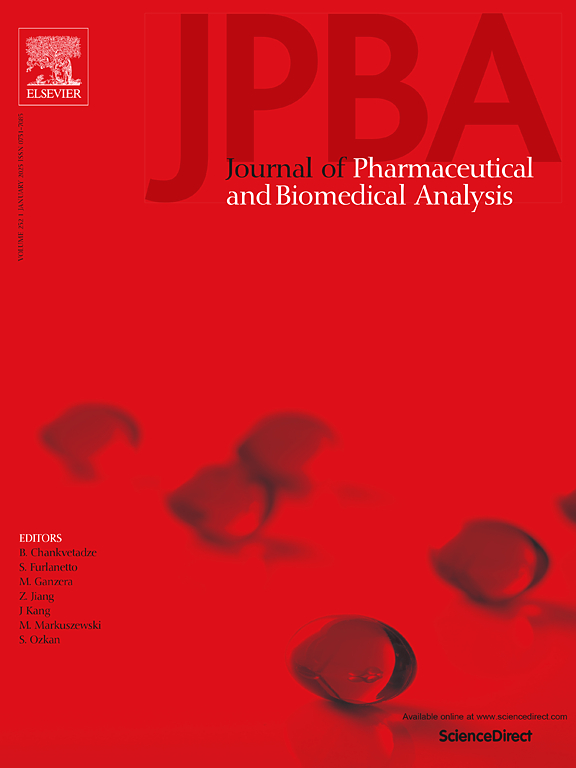Two-phase hollow fiber based liquid phase microextraction using hydrophobic deep eutectic solvents for extraction of trace amounts of benzodiazepines in biological samples
IF 3.1
3区 医学
Q2 CHEMISTRY, ANALYTICAL
Journal of pharmaceutical and biomedical analysis
Pub Date : 2025-07-10
DOI:10.1016/j.jpba.2025.117061
引用次数: 0
Abstract
This study carefully prepared hydrophobic deep eutectic solvents (H-DESs) for the acceptor phase in two-phase hollow fiber liquid phase microextraction (HF-LPME). This innovative approach was used for the extraction of benzodiazepines from biological samples. H-DESs were synthesized using five different compounds: menthol, choline chloride, lauric acid, decanoic acid, and octanoic acid, which were in specific molar ratios. High-performance liquid chromatography with UV detection was employed to analyze the extracted analytes. Various parameters influencing the extraction efficiency of benzodiazepine were carefully optimized and investigated. Under the optimized conditions, a linear dynamic range of 1–1000 μg/L was achieved with correlation coefficients greater than 0.991. Quantitation limits in the 1–5 μg/L range and detection limits between 0.3 and 1.5 μg/L were obtained. Preconcentration factors in the range of 89–145 were also obtained.
The method was employed for the extraction and determination of benzodiazepines biological samples, resulting in favorable results.
疏水深共晶溶剂两相中空纤维液相微萃取萃取生物样品中微量苯二氮卓类药物
本研究精心制备了两相中空纤维液相微萃取(HF-LPME)中受体相的疏水深共晶溶剂(H-DESs)。这种创新的方法被用于从生物样品中提取苯二氮卓类药物。采用五种不同的化合物:薄荷醇、氯化胆碱、月桂酸、癸酸和辛酸,按特定的摩尔比合成h - des。采用高效液相色谱-紫外检测对提取物进行分析。对影响苯二氮卓提取效率的各参数进行了优化研究。在优化条件下,其线性动态范围为1 ~ 1000 μg/L,相关系数大于0.991。定量限为1 ~ 5 μg/L,检出限为0.3 ~ 1.5 μg/L。得到了89 ~ 145范围内的富集系数。将该方法用于苯二氮卓类生物样品的提取和测定,取得了较好的结果。
本文章由计算机程序翻译,如有差异,请以英文原文为准。
求助全文
约1分钟内获得全文
求助全文
来源期刊
CiteScore
6.70
自引率
5.90%
发文量
588
审稿时长
37 days
期刊介绍:
This journal is an international medium directed towards the needs of academic, clinical, government and industrial analysis by publishing original research reports and critical reviews on pharmaceutical and biomedical analysis. It covers the interdisciplinary aspects of analysis in the pharmaceutical, biomedical and clinical sciences, including developments in analytical methodology, instrumentation, computation and interpretation. Submissions on novel applications focusing on drug purity and stability studies, pharmacokinetics, therapeutic monitoring, metabolic profiling; drug-related aspects of analytical biochemistry and forensic toxicology; quality assurance in the pharmaceutical industry are also welcome.
Studies from areas of well established and poorly selective methods, such as UV-VIS spectrophotometry (including derivative and multi-wavelength measurements), basic electroanalytical (potentiometric, polarographic and voltammetric) methods, fluorimetry, flow-injection analysis, etc. are accepted for publication in exceptional cases only, if a unique and substantial advantage over presently known systems is demonstrated. The same applies to the assay of simple drug formulations by any kind of methods and the determination of drugs in biological samples based merely on spiked samples. Drug purity/stability studies should contain information on the structure elucidation of the impurities/degradants.

 求助内容:
求助内容: 应助结果提醒方式:
应助结果提醒方式:


